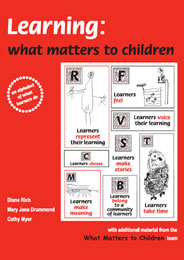|
Learning:
what matters to children
by Diane Rich, Mary Jane Drummond, Cathy Myer Learning: what matters to children is an alphabet of what learners do.The central theme of Learning: what matters to children is what learners do. The book is arranged as an alphabet of what learners do.We continue to draw on our growing understanding of what matters to children; big ideas in children’s learning; the metaphor of food and exercise introduced in First hand experience: what matters to children and explore these more fully moving on from our original concern with the rich curriculum diet that children need.While on every alphabet page of the first hand experience book we included a number of active verbs (such as: find, investigate, collect, visit, make), which we see as activities that would naturally arise in the study of any particular topic, we did not discuss their significance, or consider how educators can best support and value the characteristic behaviours of active learners. In this book, we identify a selection of these behaviours, these ways of being a learner, and discuss their importance, drawing on our own work with children, our work with educators, our reading, our research, evaluation and development projects. We enrich these discussions with a variety of ‘learning stories’, first-hand accounts of learners who, in their spontaneous activity, play, enquiry and interactions, illustrate the ideas we are examining. We draw on and expand the key elements of our approach -what matters to children; big ideas in children’s learning; the metaphor of food and exercise. We include books and stories relevant to each concept. Learning: what matters to children is for all those who work with children from birth to 11.Learning: what matters to children will be launched at a conference in Snape Maltings, Suffolk from April 30-2 May 2008.click here to order |


